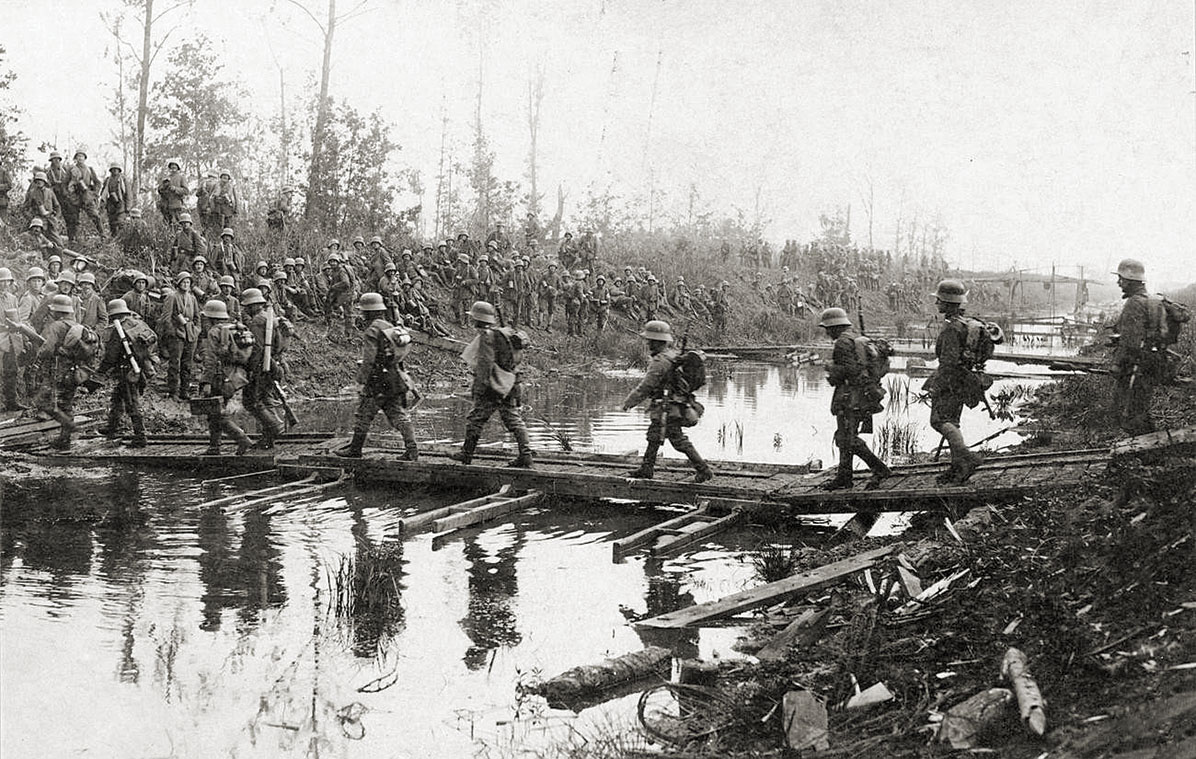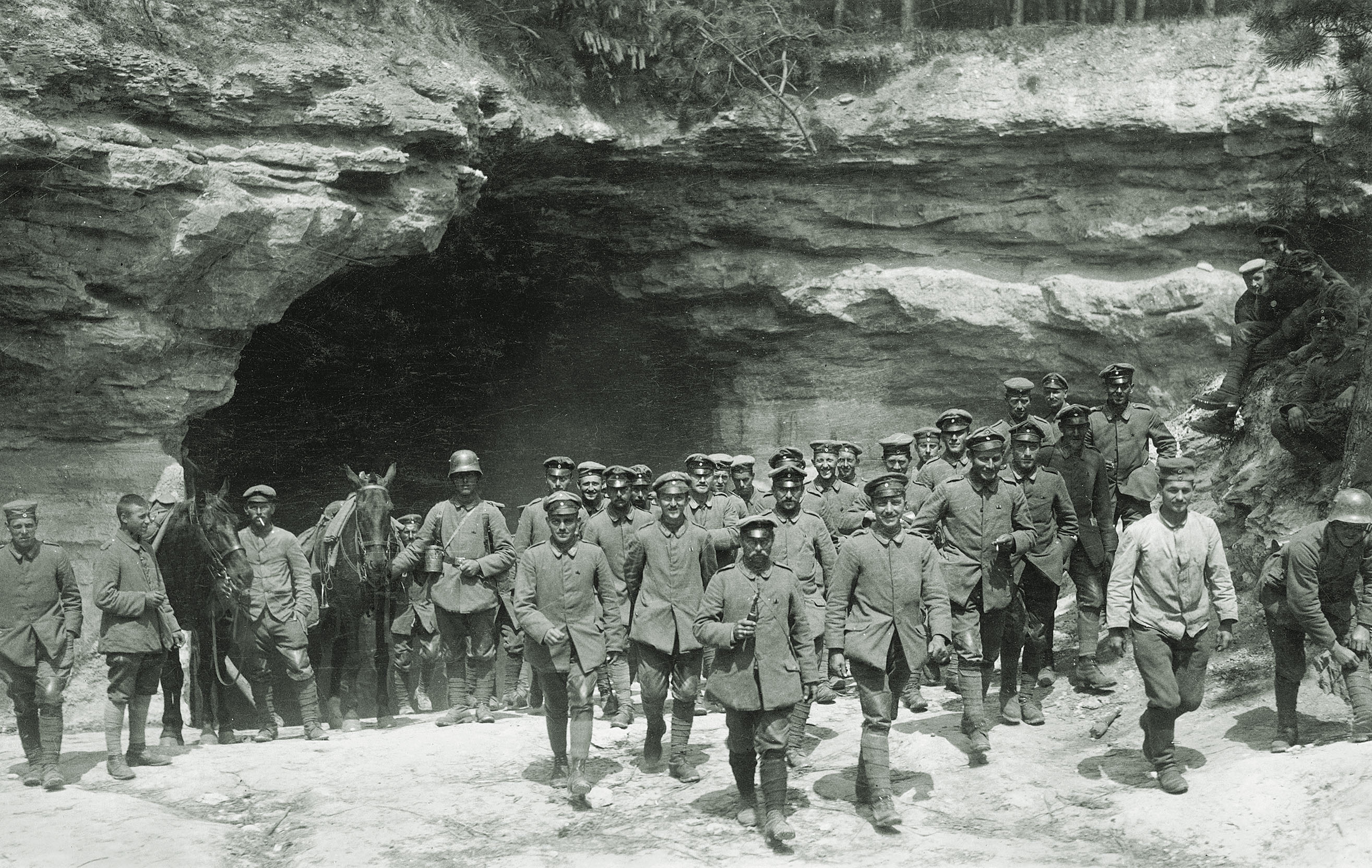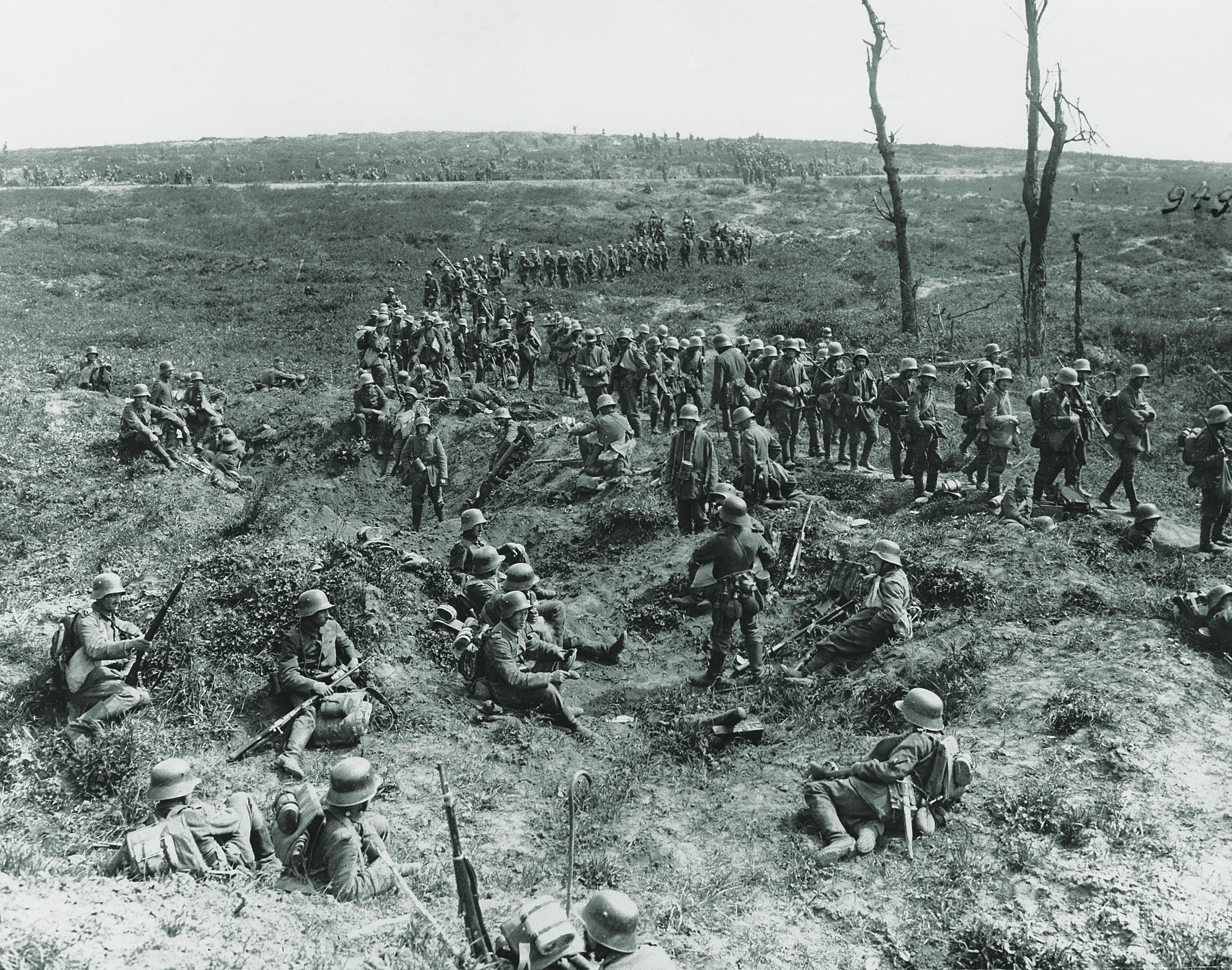By May 1918 the Germans no longer had any possible chance of winning World War I militarily.
Two great German offensives against the British Expeditionary Force (BEF) in Flanders—operations Michael (March 21–April 5), and Georgette (April 9–29)—had captured huge swaths of terrain and inflicted 367,000 casualties on the Allies.
Yet the German gains were purely tactical, resulting in no operational or strategic advantages. The German operational situation had in fact worsened, as they were left holding two very large and vulnerable salients opposite the British. The German strategic situation was worse still. The two offensives had cost them 326,000 casualties, but unlike the Allies they could not make up for the losses. Meanwhile, fresh—albeit inexperienced—American troops continued to arrive in France in large numbers.
The Germans had no realistic alternative but to shift to the defensive and work toward a negotiated end to the war. But Gen. Erich Ludendorff—who with Field Marshal Paul von Hindenburg wielded what amounted to supreme control of Germany’s military forces—could not bring himself to accept a negotiated settlement, especially since the British would insist Germany relinquish control of the Belgian coast, which both sides knew was vital to controlling the English Channel. Moreover, the stunning tactical successes achieved during Michael and Georgette only convinced Ludendorff he could force an Allied collapse with just one or two more hard pushes.
He resolved to aim those pushes primarily at the BEF in Flanders.
Days after Operation Georgette ended, Ludendorff ordered Bavarian Crown Prince Rupprecht to prepare his namesake army group for Operation Hagen, which Ludendorff envisioned as a renewal of Georgette on a far larger scale. If Hagen could push the BEF off the Continent, Ludendorff was certain the French would collapse, despite the influx of Americans.
In fact, Allied forces in Flanders were stronger than Ludendorff anticipated. In response to the recent German offensives French Gen. Ferdinand Foch, the newly appointed supreme Allied commander, had moved considerable numbers of French reinforcements north of the Somme River. The Germans would have to draw off those reserves before hoping to re-engage the BEF. Thus Ludendorff conceived a large-scale diversionary attack in Champagne, south of Saint-Quentin and west of Reims, designed to look like an attack on Paris. Ludendorff reasoned the French would pull all their reserve divisions out of Flanders to establish a blocking force to cover their capital.

On April 18 Ludendorff ordered German Crown Prince Wilhelm’s army group to start planning and preparation for Operation Blücher. Wilhelm’s forces were to sweep toward Paris over the Chemin des Dames ridge, advance a dozen or so miles to the south, cross the Vesle River and take the high ground on the far bank. Once the French reserve divisions started moving south to protect Paris, the Germans would shift rapidly back north and launch Hagen.
Spearheading Blücher was the German Seventh Army, under Col. Gen. Max von Boehn, which struck south with 29 divisions across a 43-mile front, from Chauny on the Oise River east to Loivre on the Aisne-Marne Canal, north-northwest of Reims. As in their previous two spring offensives, the Germans weighted the attack heavily with artillery, with gunnery expert Col. Georg Bruchmüller again in charge of fire planning. The Germans massed 5,263 guns against 1,422 French and British guns. The resulting 3.7-to-1 ratio was the highest artillery superiority the Germans achieved in any Western Front battle.
Up until a few days before the battle Foch believed the Germans would renew their offensive in the north. Meanwhile, the French defense in the Champagne sector centered on holding the Chemin des Dames ridge, with the Ailette River to its immediate north. The French had recaptured this dominant feature from the Germans during the April–May 1917 Nivelle Offensive. Facing the main German attack was Gen. Denis Auguste Duchêne’s weak French Sixth Army, with 11 infantry divisions in the front line and five in reserve. The force included British Lt. Gen. Sir Alexander Hamilton-Gordon’s IX Corps, which had been severely battered during the Germans’ spring offensives.
Having sustained more than 42,000 casualties in Flanders, IX Corps had been transferred south to reconstitute in a supposedly quiet sector. Sixth Army was deployed as follows:On the left French XXX Corps held the line from Pontoise-lès-Noyon east to Vauxaillon; in the center French XI Corps stretched east to Craonnelle (just west of Craonne); and on the right British IX Corps covered the line east to Loivre. Farther right still was the French 45th Division, to the northwest of Reims.
The French XI Army Corps, under Gen. Louis de Maud’huy, held a 23-mile sector. Deployed west to east in the first line, between the crest of the Chemin des Dames and the Ailette, were the 61st, 21st and 22nd divisions. Behind them the 74th, 39th and 157th divisions, respectively, held the main defensive Green Line, which ran roughly behind the Aisne River. The British IX Corps line, held by the 50th (Northumbrian), 8th and 21st divisions, ran from Bouconville-Vauclair (near Craonne) to Berméricourt (near Loivre). From the heights of the Chemin des Dames ridge the British line dropped in a southeasterly direction to Berry-au-Bac, where it crossed the Aisne and then paralleled the Aisne-Marne Canal toward Reims. The 25th Division remained in corps reserve, while a fifth British division, the 19th (Western), waited farther back near Châlons-sur-Vesle in army-level reserve. The mission of IX Corps and the French 45th Division to its right was to hold the Plateau de Californie, the eastern buttress of the Chemin des Dames. The Germans considered the plateau and the ground around Craonne the key terrain in their initial attack. The sector straddled the boundary between the French 22nd and British 50th divisions.
The German artillery opened up at 2 a.m. on May 27, taking the Allies by surprise. Though Bruchmüller’s masterful preparatory barrage lasted less than three hours, German gunners managed to damage or destroy most Allied forward positions, communications trenches, command posts and batteries. The fire effect was especially devastating, as Duchêne had ignored French army commander Gen. Philippe Pétain’s instructions to adopt a defense in depth.
When Pétain tried to force compliance with his orders, Foch backed Duchêne, who had been his chief of staff when Foch commanded XX Corps in 1914. The Sixth Army commander also rashly rejected similar warnings from his British commanders, who had had recent firsthand experience with Bruchmüller’s bombardments, dismissing his Allied subordinates with an arrogant, “J’ai dit” (“I have spoken”). Refusing to yield an inch of French soil without a fight, Duchêne foolishly packed his forces into the front lines, making them sitting ducks for Bruchmüller’s guns. The German artillery fired 3 million rounds on the first day of Blücher.
Crossing the line of departure at 4:40 a.m., 20 minutes before dawn, the German infantry advanced, preceded by a double creeping barrage. Attacking uphill along the northern base of the Chemin des Dames, they secured the eastern end of the ridge within two hours. The initial German blow fell on the French 22nd and 21st Divisions, which faced eight German divisions, while seven German divisions attacked the three British divisions in the first line.
Around 7:30 a.m. British IX Corps committed its reserve 25th Division. Within four hours of the start of the infantry assault the lead German units crossed the Aisne, 4½ miles south of the crest of the Chemin des Dames. They pushed the British 50th and 8th Divisions back across the river and enveloped the 21st Division on its right flank. In the French XI Corps sector the Germans hammered back the 22nd and 21st Divisions, while the 61st Division on the left held on for the time being. The effect was to push the right wing of French XI Corps to the southwest and away from British IX Corps, opening a gap in the Allied center.
At 11:15 a.m. Duchêne ordered XI Corps to withdraw to the Green Line—but the position had not been prepared for defense. Using infiltration tactics they had mastered during Michael and Georgette, the advancing Landser moved so fast the French and British were forced to abandon their artillery on the north bank of the Aisne. The attackers captured some 45,000 prisoners and 650 guns as they surged forward. British IX Corps lost most of its artillery. The Allies also failed to blow several key bridges over the Aisne, further facilitating the German advance. Hamilton-Gordon had received permission to blow the bridges in his sector at 12:30 p.m. Fortunately, he had already done so on his own initiative.

By 8 p.m. the Germans had pushed the French 22nd Division and the 157th Division behind it south of the Vesle. The German lead elements then crossed the river, having advanced 13 miles, exceeding the operational objective. It marked the largest single-day advance on the Western Front during the war. The French 22nd, 21st, 61st and 157th divisions had lost more than a third of their guns.
On May 28 the Germans pushed the French 22nd and 157th divisions still farther southwest, widening the gap between them and the British 25th Division to almost 10 miles. The British 19th Division, under Maj. Gen. George Jeffreys, was ordered forward. Still seriously understrength from the beating it had received that spring, the division fielded only about 9,000 troops. By day’s end the 25th Division had been badly mauled, while only remnants of the 50th, 8th and 21st divisions survived. IX Corps was ordered to hold the line of the Vesle, but as the British had almost no artillery, the Germans were able to repeatedly outflank them from the left. By 6 p.m. the Germans had pushed IX Corps south of the river, centered on Jonchery.
The German penetration to that point was nearly 15 miles deep and 42 miles wide at its base. Although Ludendorff had reached his geographic objective far more quickly than planned, there were no indicators yet that any significant numbers of French reserve units were moving out of Flanders.
Ludendorff had to make a decision. As he had done in Michael and Georgette, he abandoned the original plan and sought to exploit local tactical success. Without clearly identifying new operational objectives, he ordered the Seventh Army to continue pushing south. In support he redeployed from Flanders assault divisions he had been husbanding for Hagen. By that point nine Allied divisions, including four British, had been nearly destroyed. Recognizing it was no longer possible to re-establish a line along the Vesle and counterattack from there, Pétain at 11 p.m. redirected the Allied main effort against the German flanks, with particular emphasis on holding the Montagne de Reims, the high ground immediately south of the namesake city.
On May 29 the French center collapsed, and the Germans pushed the British left wing back to the southeast. The British 19th Division arrived in sector that day, and by noon the next day the surviving elements of the 21st, 8th, 50th and 25th divisions regrouped under the 19th. The Germans captured Soissons on the 29th and Fère-en-Tardenois, on the Ourcq River, the following day. As the Germans advanced to within a few miles of the Marne, Allied resistance seemed to disintegrate. Pétain committed his 16 available reserve divisions with little effect. Then, doing just what Ludendorff had originally anticipated, Pétain requested the transfer of Allied reserves in Flanders to his personal control. Foch, however, recognized Blücher as an operational dead-end. Unlike Michael or Georgette, it would have to culminate before reaching any significant objective. Thus he declined Pétain’s request for the time being.
On May 30 French XI Corps, which had been continually pushed to the southwest, was south of Soissons. At 11:45 a.m. Foch finally decided to commit part of his strategic reserve, the Tenth Army, of four divisions, which at that point was behind the BEF, north of the Somme. That still left the BEF in Flanders supported by the French Army Detachment of the North, with nine divisions. Pètain asked for those forces too, but Foch refused.
Although the German lead elements reached the north bank of the Marne at Château-Thierry on June 1, the German drive faltered on the shoulders of the huge salient. Thus far the Allies had managed to hold on to the important rail centers of Reims in the east and Compiègne in the west. Those key junctions controlled access to the only major rail line into the Blücher salient. Without access to that line, German logistics would soon become problematic.
By morning on June 1 the Germans had forced the left wing of the British 19th Division south of the Ardre River, though the British still held both banks below Bligny. Defending tenaciously, the 19th that day blocked the German advance up the Ardre, the main approach to the Montagne de Reims. Had the Germans taken that key piece of high ground south of Reims, the city would have fallen. Had that happened, the Germans would have been able to open up a major rail line into their huge salient.
Among the reinforcements Foch did feed to Pétain were the U.S. 2nd and 3rd divisions. In three days of fighting around Château-Thierry, beginning on June 1, the Americans repulsed repeated German attempts to cross the river, earning the title “Rock of the Marne” the 3rd Division still carries. The Germans’ worst nightmare had come to pass: The Americans were making their presence felt on the Western Front far sooner than anticipated.
Finally, on June 6, Crown Prince Wilhelm’s army group halted Blücher and ordered the Seventh Army to dig in. Although Paris had never been their real objective, the Germans were within 45 miles of the French capital. While the situation for the Allies appeared desperate, the Germans were in no position to exploit their advantage. They lacked the combat power, mobility or logistics to reach Paris, even if they had wanted to.
Over 11 days of fighting the Allies had suffered upward of 127,000 casualties. The Germans had lost fewer men, some 105,000, but all they had to show for it was another huge salient to defend. Worse, lines of communication into the Blücher salient were poor and incapable of supporting the logistics flow necessary to maintain the troops defending it. Worse still, Ludendorff had squandered 13 of the 26 Hagen attack divisions in Blücher, and those divisions had to be reconstituted. Before he could even think of trying to launch Hagen, Ludendorff would have to wrest control of the Compiègne–Reims rail line by seizing the hub at either end. That imperative drove the fourth and fifth of Ludendorff’s 1918 offensives, Operations Gneisenau (June 9–13) and Marneschutz-Reims (July 15–18). With the failure of those operations the Germans were forced to scrub Hagen, and on July 18 the Allies launched a massive counterattack into the Germans’ overextended Blücher salient, opening the Second Battle of the Marne.
What was left of the British IX Corps units transferred back to Flanders between June 19 and 30. IX Corps’ casualties from Blücher came to 1,298 officers and 27,405 other ranks. The remnants of the 8th and 25th divisions had been reduced to two composite battalions, and the survivors of the 50th and 21st divisions were grouped into two composite brigades.
Although an outstanding German tactical success, Operation Blücher (the Third Battle of the Aisne) not only denied Ludendorff further success in Flanders but also set the conditions for the Allies’ decisive operational-level victory on the Marne, giving them an overextended salient to attack, one thinly defended by exhausted and inadequately supplied troops.
Had Reims fallen, the operational situation in early June 1918 would have looked much different. By preventing the Germans from capturing the key high ground of the Montagne de Reims, the remnants of British IX Corps fighting under its 19th Division probably prevented Reims and its vital rail center from falling into German hands. In the process the Germans lost their last viable operational possibility for any sort of battlefield victory—or even a battlefield stalemate—in 1918. Its failure to take Reims proved the final nail in Germany’s strategic coffin. If the Germans’ failure to take Amiens in March was their World War I strategic equivalent of Stalingrad, then their failure to take Reims was their Kursk. MH
Retired U.S. Army Maj. Gen. David T. Zabecki is Historynet’s chief military historian. For further reading he recommends his own The Generals’ War: Operational Level Command on the Western Front in 1918, as well as The Nineteenth Division, 1914–1918, by Everard Wyrall.
This article appeared in the May 2021 issue of Military History magazine. For more stories, subscribe here and visit us on Facebook:






